Design Sprint inspired from Design Thinking is a 5-step process conducted by an interdisciplinary team over a working week. Clearly, its purpose is to reduce risk of a new product or service by confirming the main assumptions or unknown with rapid prototyping and testing.
Pioneers from Google created Design Sprint in 2010 as they were looking for a new way to create product and move away from traditional approach.
- Design sprint: overview of the 5-step process
- Set the stage: preparation of the Design Sprint
- Design Sprint Day 1, Monday – Understand the problem
- Design Sprint Day 2, Tuesday – Ideate for competing sketches of prototype
- Design Sprint Day 3, Wednesday – Decide and plan for the Prototype
- Design Sprint Day 4, Thursday – Build the Prototype
- Design Sprint Day 5, Friday – Test the Prototype with customers
- What’s next? Learn about other frameworks around Product Development like Lean Startup, Story Mapping, Impact Mapping and Agile
- Do you want to learn more about Design Sprint? Here are some valuable references
Design sprint: overview of the 5-step process
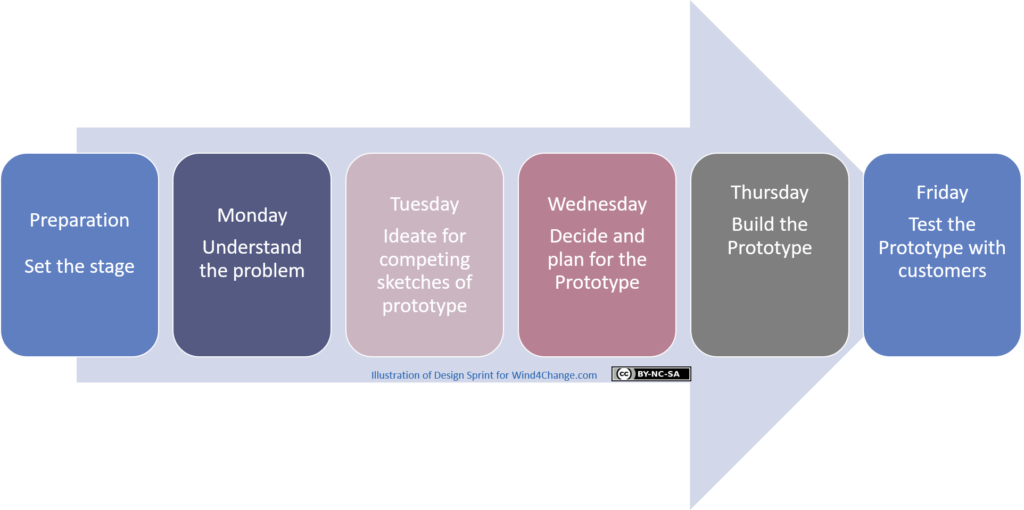
- Monday
- In the morning, identify the problem and consolidate it as a map.
- In the afternoon, interview experts then pick the piece of problem to solve.
- Tuesday
- In the morning, review existing ideas for inspiration from the company and other markets.
- In the afternoon, individually sketch a solution.
- Wednesday
- In the morning, review and evaluate each competing sketch of Prototype then select the best to address the problem.
- In the afternoon, storyboard the Prototype and confirm consistency.
- Thursday
- Build the good enough Prototype to support a realistic simulation and learn.
- Friday
- Conduct 5 Prototype tests and interviews with customers.
- Review highlights, identify patterns and share learnings.
Set the stage: preparation of the Design Sprint
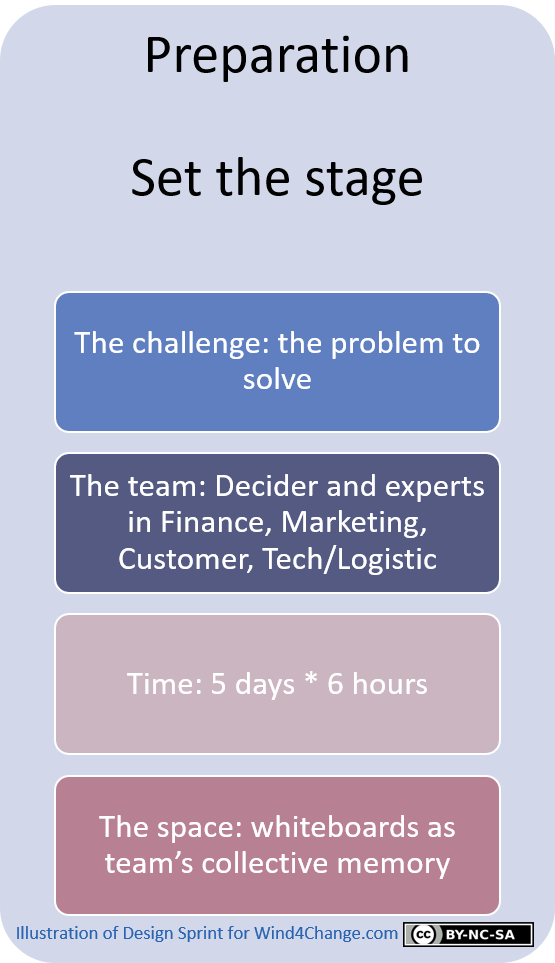
4 elements are required to prepare the Design Sprint:
- The right challenge
- The right team
- The time, with team members’ agenda freed up for the full week
- The space
In addition, even if it occurs mid-week in the official Design Sprint planning, it may be a good thing to identify and ensure availability of your customers for the test scheduled on Friday.
The challenge
Design Sprint is demanding regarding energy and focus, as you dedicate a team to it during a the week. So, you need to make sure that there is enough at stake and that the challenge is big. Actually, people won’t clear their agenda if it is not the case.
A good challenge will be a mix of high stakes for instance the last confirmation before going full speed, a deadline as you are running out of time, or because you are just blocked and your initiative needs new a fresh start.
The team
The Decider
The Decider is the official decision-maker for the initiative. Actually, he or she should understand the problem, have an opinion about it and its success criteria. In big companies, it it typically a VP or a Product Manager. In a startup, it will be directly the CEO.
If the Decider can’t dedicate the full week to The Design Sprint, secure his or availability at least on:
- Monday, to share his or her perspective on the problem.
- Wednesday, to choose the right idea to test.
- Friday, to see how customers react to the prototype.
In addition, there is the need to have an official delegate of the Decider in the room all the week.
The composition of the team
In Design Sprint, the optimal size is considered 7 or less people. The team should cover all areas of expertise and the members should be excited about the challenge. Typical profiles to include for proper coverage of knowledge are:
- Finance expert who can explain where the money comes from and where it goes.
- Marketing expert who crafts the company’s messages.
- Customer expert who regularly and closely interacts with the customers.
- Technology and logistic expert who understands what the company can build and deliver.
At last, a sanity question to build your team is:
Who might cause trouble if he or she isn’t included?
In addition, troublemakers bring different perspectives that can enrich the team but also push everyone else to do better work.
Note that if you have identified more than seven people, you may have some of them contributing as experts on Monday afternoon.
The facilitator
The Facilitator is responsible for managing the overall process, the exchanges and enforces time keeping. Truly, as Design Sprint is a demanding exercise, he or she should have demonstrated these skills in other workshops. At last, do not combine the Decider and the Facilitator roles. Indeed, the Facilitator must remain unbiased about decisions.
The time
Time format is a given with 5 days of 6 hours. Surely, a time period short enough to create a momentum and enforce a focus, but long enough to build and test a prototype without working to exhaustion. 6 working hours is the maximum for the team to remain focus and high energy. In addition, make sure that you start early, so remaining working time, for people to catch up with their day to day activity, is at the end. As a result, you do not take the risk of loosing people physically or intellectually as the got trapped in issues from their regular work.
There are in addition rules to support focus and the proper use of the time:
- No laptops, phones, or tablets are allowed. Clearly, if you’re looking at a screen, you’re not paying attention to what the team is working on, so you can’t help. Moreover, you’re unconsciously saying that you are not interested.
- But, there is still the possibility to manage quick emergencies with the condition of leaving the room to do so.
The space
Human beings have a poor short-term memory. But they have a great spatial memory. As a consequence, the Design Sprint room fully leverages this aspect with the relevant pieces of equipment: two big whiteboards minimum or the equivalent area of sticky walls and all related materials like sticky notes, markers and other visual materials. To illustrate, the room becomes a kind of shared memory for the team.
Design Sprint Day 1, Monday – Understand the problem
Monday Morning, identify the problem and build related map
Identify the long-term goal and difficult questions to answer
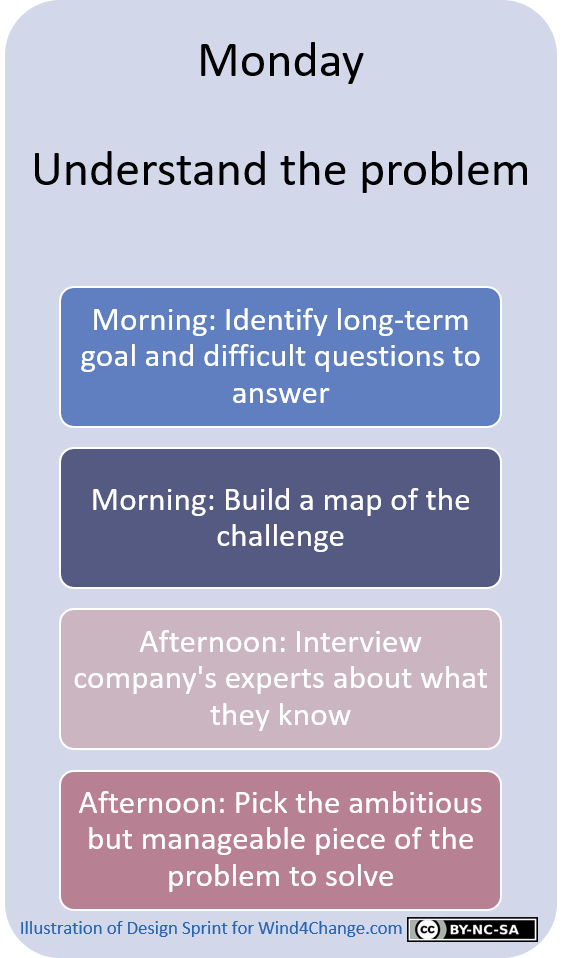
Monday’s work sets the frame and the path for the sprint week to address the main the assumptions, unknowns then risks. The approach starts with the end, the objectives, with defining the key questions to answer.
After a positive warm up with the overall direction on medium and long term of the project, from 6 months to 5 years from now, the team focuses on the weak side of the project. To do so, the team uses a sort of premortem approach imagining that the project was a disaster! Surely, it is the opportunity to focus on what could go wrong and potential reasons for failure.
Indeed, dangerous assumptions hide behind goals. Clearly, the longer these assumptions remain, the greater the risk. So, Design Sprint is the opportunity to identify these assumptions and turn them into questions. As a result, assumptions will turn to facts.
Actually, the first main important step in Design Sprint is rephrasing assumptions and risks into questions. In addition, this stresses a switch of mindset from an uncomfortable uncertainty to an exciting curiosity.
Build a map of the challenge
The map is the second element that structures the week. To put it differently, it narrows the broad challenge into a specific target for the Design Sprint. Then, later in the week, the map will provide a frame to sketch and prototype. In addition, the map makes it possible to consolidate all key elements in a simple way and to check consistency. At last, it works as team’s short-term memory to release the team’s cognitive workload and to fully leverage human spatial understanding.
A Design Sprint map is a simple customer-centric story, made of words, arrows, and boxes. Furthermore, it structures over:
- The key actors of the story displayed on the left.
- Then, the end of the story on the right.
- At last, the 5 to 15 steps describing the story with words and arrows in between.
Monday Afternoon, interview the experts and choose the piece of problem to solve
Interview company’s experts about what they know
Truly, the team knows already a lot about the challenge. But this knowledge is distributed and may be outside the team or even outside the company. So, the beginning of the afternoon starts with interviewing experts to gather more information about the challenge and its context. Meanwhile, the team collects learnings, takes notes, adds new questions and updates the map accordingly.
Typical topics that experts cover:
- Strategy, and you should start by interviewing the decider. Examples of questions are:
- What will make this project a success?
- Then what’s our unique advantage or opportunity?
- At last, what’s the biggest risk?
- Voice of the Customer: truly, there is nobody better to talk about customers and their view of the world than the customers themselves.
- Marketing: people who know about the company’s messages.
- Technology and logistic experts who understand what the company can build and deliver: these will be the designers and the engineers.
- Finance: people who can explain where the money comes from and where it goes.
- All other relevant experts depending on the specificities of your product or challenge.
In addition, in order to take advantage of previous efforts on similar initiatives, it may be valuable to interview people who worked on on going initiatives, unfinished or failed ideas to build on them with fixing and completion.
The approach for the interviews
- Collect what the expert knows about the topic.
- Take notes as a team, rephrasing each problem you hear into an opportunity. For this, we use “How Might We” format.
- Ask the expert to tell where the team understanding is incomplete or incorrect.
- Invite the expert to add questions and opportunities to team’s list if he or she sees any.
- After the each interview, the team adjusts the map and if necessary updates the long-term goal.
Pick the ambitious but manageable piece of the problem to solve
The task on Monday is to choose a target for your Design Sprint. This is the role of the Decider who chooses one target customer and one target event on the map to focus on. As a result, the rest of the Design Sprint with sketches, prototype, and test will result from this decision.
Once the target is set, the team rescans all the questions to highlight those in line with the target to address in priority.
Design Sprint Day 2, Tuesday – Ideate for competing sketches of prototype
Now that the team has defined the challenge and chosen a target, it is time to work on the solution.
Tuesday morning, review of existing ideas from the company and other markets to remix and improve
To foster inspiration, the day begins with a review of existing ideas to remix and improve.
It’s like playing with Lego bricks: first gather useful components, then convert them into something original and new.
Lightning Demos in Tuesday morning
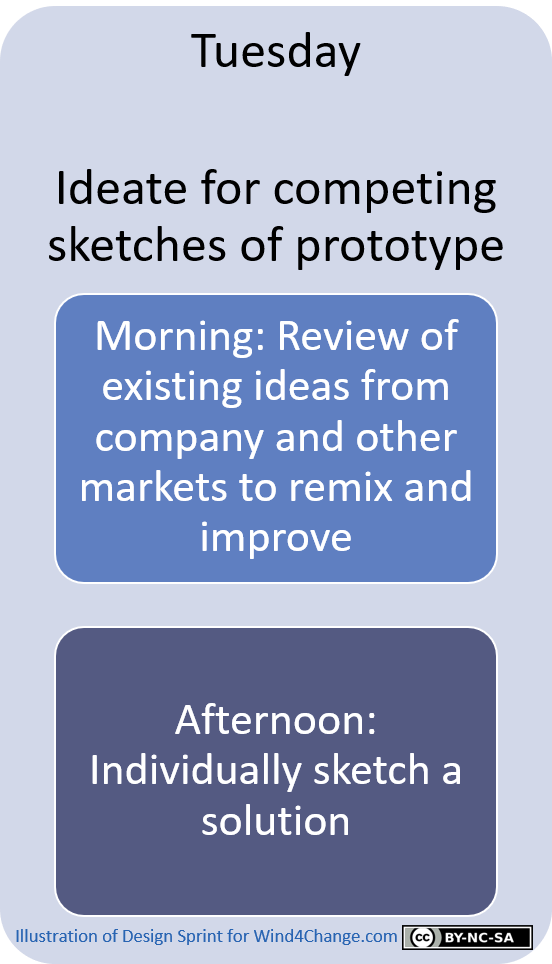
Design Sprint uses Lightning Demos to collect and consolidate existing ideas.
The approach is for each team members to present their favorite solutions in 3 minutes. The source of inspiration are various, such as from the company, from other products and even from different domains. Indeed, best inspiration comes from similar problems in different market. Surely, the approach is to find raw materials to elaborate on, not just to copy. But do not skip work in progress, unfinished or abandoned ideas from your company that can be quite useful when adjusted.
In addition, as each team member presents his or her 3-minute Lightning Demo, take notes on what might be useful. Surely, don’t make decisions or discuss ideas. As a result, all these notes will support team shared memory as played by display boards. The output of this workshop should be between 10 to 20 ideas.
Tuesday afternoon, the 4-step individual sketch
Tuesday afternoon is dedicated to sketch competing solutions as each team member will work individually on his or her own. So, no common brainstorm here as the creators of the approach consider that there is more creativity and diversity in individual sketching. Each team member works alone and has time to do research, find inspiration and think out the problem. Then the team will select the best sketch.
In addition, other part of the rational is that as abstract ideas lack concrete details, they can easily be undervalued or overvalued depending on the reputation, the status or the presentation skill of the person behind them. So, comparison should happen when the idea became concrete through sketch.
Each team members will follow the same process over about 1 hour and a half
- Take notes (20 minutes) based on the team spatial memory on goals, opportunities and inspirations as displayed in the room to refresh one’s memory.
- Capture rough ideas (20 minutes) in all format to give shape to thoughts. This can be doodles, stick figures in action, diagrams or headlines.
- Stretch ideas with Crazy 8s (8 minutes), the Crazy 8s is crazy for the pace as the approach is to sketch eight variations in eight minutes of the good ideas to improve them and consider alternatives. So it is not about having new goofy ideas.
- Sketch the solution as a 3-panel storyboard (30 minutes) still in the same simple format with words, boxes, sticky notes all this drawn with markers. Clearly, the customer and his or her experience with the product or the service is at the center.
Guidelines about the sketch
- Self-explanatory.
- Anonymous, to avoid the bias demonstrated above, so the sketch will be evaluated for its intrinsic value with genuine critics not for its author.
- Ugly is okay as what matters is detail and thought.
- Words matter as they usually stand for a key part of the solution.
- Catchy title to make an easy reference to the sketched solution when reviewing and choosing.
Once everybody is done, store the sketches but do not look at them. Definitively, you want to look at them with fresh eyes on the following day, Wednesday.
Design Sprint Day 3, Wednesday – Decide and plan for the Prototype
Wednesday morning, review prototype sketches and choose the one to build
Human beings have a limited short-term memory and a limited energy for decision-making. Surely, if we jump from option to option it is too much detail to manage. On the contrary, if we debate a single idea for too long, we get exhausted. So, the Design Sprint process is sequential to evaluate all solutions at once, all critics at once and finally make a decision at the end for all. Clearly, the magic comes with dot stickers and sticky notes. Indeed, dot stickers enable to express opinions without debate and without making decision and the sticky notes allow to record key ideas without relying on our short-term memory.
Review and evaluate each competing sketch of Prototype
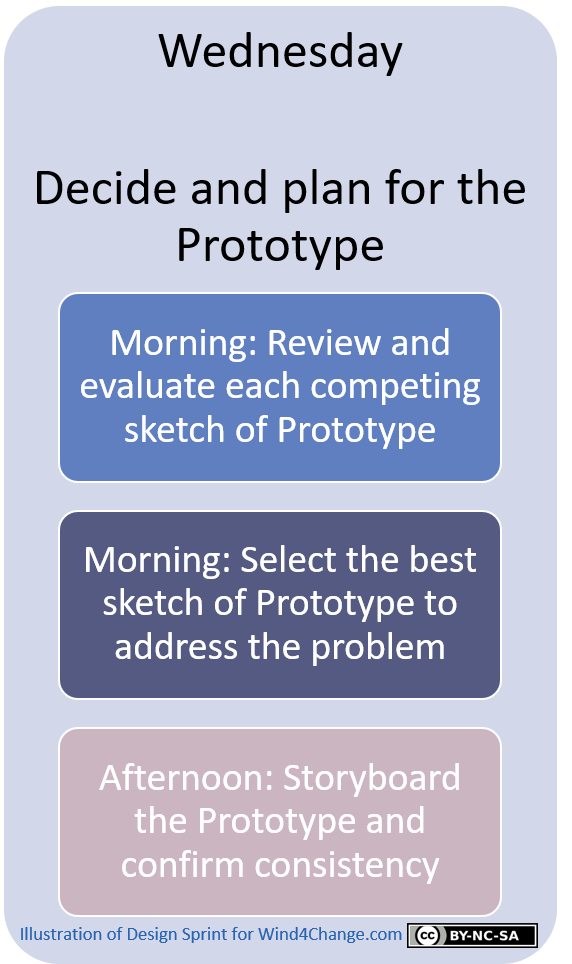
- Art museum: display solution sketches on the wall.
- Heat map:
- Review all the solutions in silence and use dot stickers to mark interesting parts.
- There are no limits with number of dots and there is no rule. For instance, people can put dots on their own sketch.
- You can mark the most interesting ideas with 2 or 3 dots for a person. Do not go further.
- The heat map approach ensures that you make the most of your first, uninformed look at the sketches.
- In case of question or concern, write a sticky note to keep a trace of it and display it below the sketch.
- Speed critique: quickly discuss the main elements of each solution and capture key ideas with sticky notes.
- Gather around a solution sketch and set a timer for 3 minutes.
- The Facilitator:
- Describes the sketch with the actions performed by the customer.
- Highlights ideas with clusters of stickers by them.
- The team complete with missed ideas.
- The Scribe writes key ideas on sticky notes and sticks them above the sketch.
- The creator of the sketch:
- Remains silent until the end when solicited by the facilitator to reveal his or her identity. Clearly, this is critical to save time, remove redundancy and guarantee genuine discussion.
- Explains any missed ideas and answers questions.
Select the best sketch of Prototype to address the problem
- Straw poll:
- Each team member selects one solution and marks it with a dot sticker at the end of the 10-minute time period. Note that these votes are for information to give advices to the decider who remains in charge of choosing the solution.
- The team members votes can be for a whole sketch or just a part of it.
- Each team member then explains his or her vote in one minute while the Decider listens.
- Supervote: the Decider makes the final decision for the solution to prototype and test.
Wednesday afternoon, storyboard the Prototype and confirm consistency
Before prototyping, you need to check consistency and if there are unanswered questions. Truly, you do not want your prototype to fall apart because pieces do not fit together. So, this is the purpose of the plan for the prototype and the focus of the afternoon.
To illustrate, the team will turn the winning sketch into a storyboard with 10 to 15 frames describing a consistent story.
Opening is essential, so you need to have a good one. Clearly, the opening scene will increase the quality of your test if you can make it real. As a result, customers will forget they’re trying a prototype and react naturally.
Examples of openers can be:
Web search with your website nestled among the results
Magazine with an advertisement for your service
Store shelf with your product sitting beside its competitors
App Store with your app in it
News article that mentions your service, and possibly some competitor
Facebook or Twitter feed with your product shared among the other posts
Other pieces of advice to set a good prototype plan include:
- Integrate just enough detail so the sequence of events and actions are clear to all when prototyping on Thursday. But not too much as this would prevent creativity.
- Keep the plan short: 15 frames maximum with a scenario to be played in 15 minutes. In other words, a frame should stand for one minute of the test.
Design Sprint Day 4, Thursday – Build the Prototype
Build the good enough Prototype to support a realistic simulation and learn
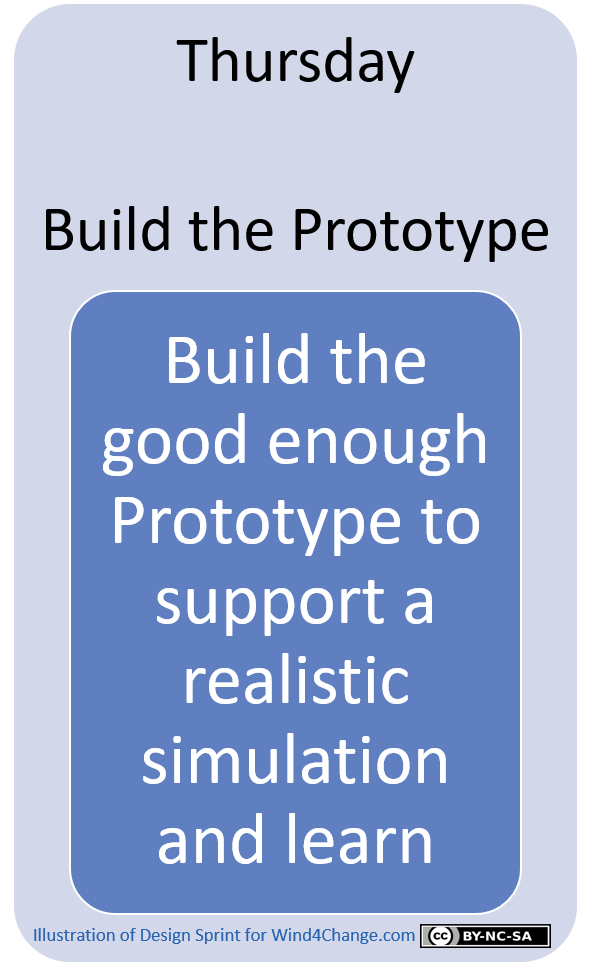
On Thursday the team dedicates the day to build a realistic prototype. On day is the compromise considered by the creators of the Design Sprint to be long enough for the prototype to be good enough to get genuine feedback from the customer and at the same time, short enough so you do not overinvest and slow down the learning process. To put it differently, as the authors refer to the Goldilocks principle: Not too high, not too low, but just right.
In addition, it prevent the team from being attached to the prototype and close themselves from negative feedback.
After one day, you’re receptive to feedback. After three months, you’re committed.
To prototype your solution, you’ll need a temporary change of philosophy: from perfect to just enough, from long-term quality to temporary simulation.
Principles with Prototyping
- You can prototype everything: be optimistic and convinced that you will find a way to prototype. Surely, Google Venture demonstrated it with their long experience in prototyping.
- Prototypes are one-use to support a simulation.
- Build just enough to learn, nothing more.
- Prototypes must appear real, so customers will get in the scenario and experience genuine reactions.
Select your tool for Prototyping
Pick the right tool to support your prototype and simulation. In 90% of the cases, it will be in PowerPoint or Keynote. For physical product, in addition, you may use a 3D printing or customize an existing product. Surely, their screen will be simulated with PowerPoint or Keynote too.
At last, you may not need a physical prototype at all and use a trick like the Brochure Façade. Instead of prototyping the device, prototype the website, the video or the brochure designed to sell the product.
Some illustrations of Prototypes may be:
– Firstly, if it’s on a screen (website, app, software, etc.) – use Keynote, PowerPoint, or a website-building tool like Squarespace.
– Secondly, if it’s on paper (report, brochure, flyer, etc.) – use Keynote, PowerPoint, or word processing software like Microsoft Word.
– Fourthly, if it’s a service (customer support, client service, medical care, etc.) – write a script and use your sprint team as actors.
– Then, if it’s a physical space (store, office lobby, etc.) – modify an existing space.
– At last, if it’s an object (physical product, machinery, etc.) – modify an existing object, 3D print a prototype, or prototype the marketing using Keynote or PowerPoint and photos or renderings of the object.
Share the tasks between roles to build your Prototype
- Makers: create single components standing for a screen, a page or a piece of the product for the prototype.
- The Stitcher: is the person in charge of collecting components from the Makers and combining them seamlessly. In addition to consolidating parts, he or she makes sure that the prototype is consistent from beginning to end and that all the simulation steps are as realistic as possible.
- Writer: is the team member responsible for composing realist texts. Truly, you cannot build a convincing Prototype without realist texts.
- Asset Collectors: is the person who looks for raw material in the web or from other products to find photos, icons, or other contents so the team do not build them from scratch.
- Interviewer: is the team member who will lead the interview on Friday for the Prototype test with users. To do so, he or she prepares them with an interview script. And it is better for this person not to work on the prototype. This way, he or she won’t be emotionally invested in the tests of the Prototype on Friday. Clearly, this is another way to secure genuine feedback from customers and to limit cognitive biases.
Trial run
Around 15:00, the team performs a trial run, so it is early enough to fix issues in the prototype. To illustrate, all the team pauses work and gathers around the Stitcher who goes through the entire prototype and narrates as he or she does.
Meanwhile, the Interviewer assists to get familiar with the prototype. Clearly, this is necessary to properly support the simulation and get the most out of the interviews. In addition, the Decider assists to make sure that the prototype and the simulation properly cover his or her expectations.
Design Sprint Day 5, Friday – Test the Prototype with customers
Friday, is the conclusion of the Design Sprint with the last step: watching customers react to your prototype then interview them and at last harvest your learnings.
5 is the magic number
Surprisingly, you just need 5 people to be able to observe 85% of the problems. Truly, this keep the effort low and the feedback loop fast. So there is no need to test with more people as benefit will be marginal and work effort will raise proportionally.
Furthermore, one-on-one interviews after the test with the prototype are quite valuable. Indeed, they enable to get an incredible amount of insights fast and learn about the critical information on why things work or not.
The 5-step simulation and interview
Start with a friendly welcome
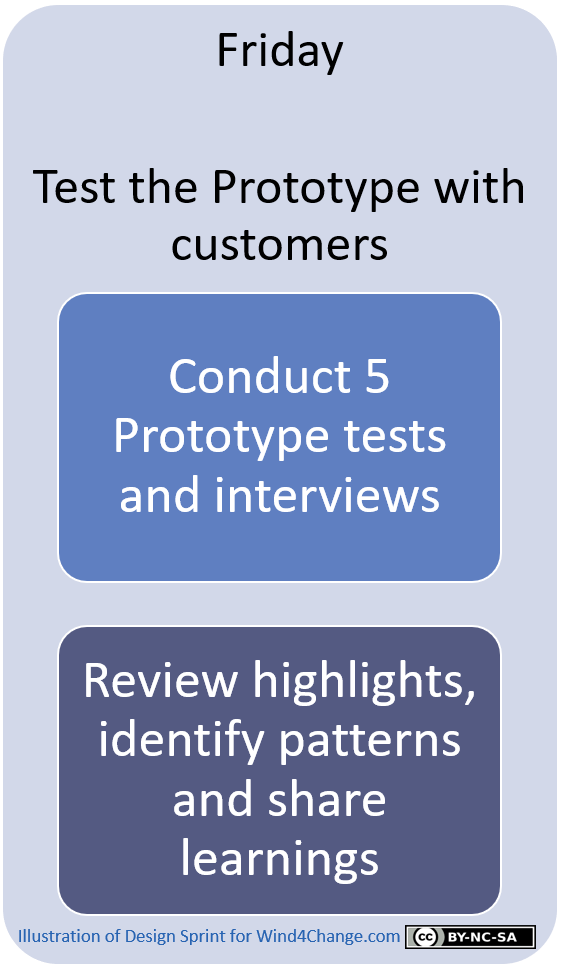
You want to start with an informal and friendly interview so the customer feels comfortable and safe. Surely, this is critical to get the natural behavior and the genuine feedback you need. In addition, be clear that what you test is the prototype, not the customer and that you will ask many questions. Furthermore, tell the customer that it is fine if he or she gets confused because it is a prototype and that the problem is likely to come from it. Actually, stress that all issues are good news as they are opportunities for the team to fix them.
At last, get the confirmation and explain the reason to record and to watch the video of the simulation. Beside that, you may have to sign legal papers at least for non disclosure.
Warm up with general open questions on the context of the customer
In order to build the connection with the customer and get background elements, start with a series of open questions to learn about he customer’s life, activities and interests. Definitively, they will help you to understand and interpret reactions and responses of the customer.
DO ask “Five Ws and One H” questions.
(“Who… ?” “What… ?” “Where… ?” “When… ?” “Why… ?” “How… ?”)
DON’T ask multiple choice or “yes/no” questions.
(“Would you… ?” “Do you… ?” “Is it… ?”)
Introduction to the prototype
Ask the permission to the customer to have him or her look to your prototype. Really, this will contribute again to his or her confidence and the value of his or her reaction and feedback. Likewise, this is still to get genuine behavior and insight. Once again, this reminds that the test is about the prototype, not the customer and that some things may not be working properly.
At last, request your customer to think out loud when proceeding with the prototype. In other words, suggest him or her to tell what they do or try to do, what they think, what they like or not. And if he or she is confused or don’t understand something, let them tell you.
Without a doubt, thinking aloud makes you get insight you will not collect with other traditional formats. Surely, watching customers interacting and reacting with your prototype is useful, but hearing their thoughts as they proceed is priceless.
Nudge instructions for prototype exploration
You want to support the customer with the exploration of the prototype but with a light support so they have enough to move and not to feel lost, but it is not too prescriptive.
Good task instructions are like clues for a treasure hunt – it’s no fun (and not useful) if you’re told where to go and what to do. You want to watch customers figure out the prototype on their own.
Open-ended tasks lead to interesting interviews. Overly specific tasks are boring for both the customer and the sprint team.
Moreover, as the customer proceeds with the exploration of the prototype, the Interviewer supports them to think out loud with questions like:
“What is this? And, what is it for?”
“Then, what do you think of that?”
“What do you expect that will do?”
“So, what goes through your mind as you look at this?”
“What are you looking for?”
“At last, what would you do next? Why?”
These questions should be easy to answer and asked with a comforting tone. Really, Interviewer just tries to keep the customer moving and thinking aloud, not making him or her feel anxious about finding the correct answer!
At last, develop curiosity mindset about your customer: focus on surprising details of what your customers do and say. And always ask why? Do not assume or jump to conclusions without taking the opportunity to have the confirmation directly form your customer. As a matter of fact, the customer is just in front of you!
Debrief the learning from prototype simulation and interview
Let’s stress that all the team watches the interviews all together. Not only it is faster but also because this guarantees that all the team has the same level of information. In addition, during the interview team members write sticky note when they hear or see something interesting.
To illustrate, these can be quotes, observations or interpretations of what happened. Furthermore, all this is captured in a 5-column format, one for each customer and rows depending on main questions to answer. But during the interviews, the room remains quiet. All attention is on observation, not reacting or worse debating.
As all the team has the interviews and learnings in short-term memory, they move to the last step to debrief learnings and decide the next actions.
The debrief comes in 3 steps:
- The team members review silently the notes over 5 minutes and take notes on a paperpad on there side. The objective here is to look for patterns that show up with 3 or more customers, or strong reactions for at least 2 customers.
- The a collective sharing of patterns the team found. Meanwhile, on another whiteboard, the facilitator lists patterns and labels them as positive, negative, or neutral.
- The team reviews these patterns based on Monday’s questions about assumptions, risks and long-term goal, so they can prioritize them and decide the next actions.
What’s next? Learn about other frameworks around Product Development like Lean Startup, Story Mapping, Impact Mapping and Agile
- To learn more about other frameworks supporting Product Development like Lean Startup, Story Mapping and Impact Mapping check my other post.
- Review my post about Design Thinking.
- In addition, you can review my posts introducing Agile and Agile at Scale.
- At last, learn more about innovation with all my posts about Digital and the disruptive technologies.
Do you want to learn more about Design Sprint? Here are some valuable references
Web references:
- Wikipedia page on Design Sprint
- The page from Google company on Design Sprint
- The page from Google venture on Design Sprint
- If you want to discover or refresh your memory on the Goldilocks principle: “Not too high, not too low, but just right.”
Design Sprint book:
- Sprint by the creators of the Design Sprint from Google Venture
